FIAT FREEMONT 2014 1.G Owners Manual
Manufacturer: FIAT, Model Year: 2014, Model line: FREEMONT, Model: FIAT FREEMONT 2014 1.GPages: 388, PDF Size: 4.13 MB
Page 131 of 388
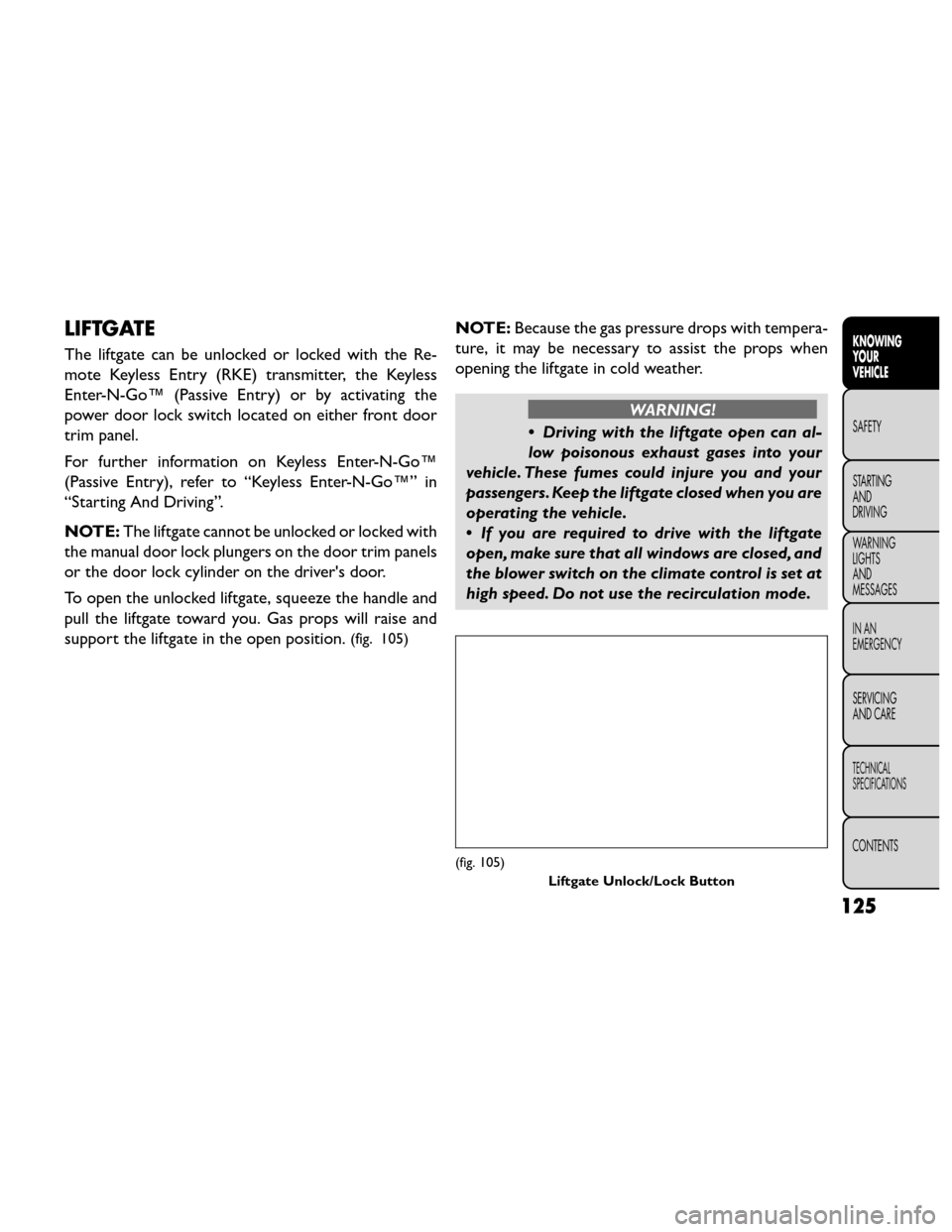
LIFTGATE
The liftgate can be unlocked or locked with the Re-
mote Keyless Entry (RKE) transmitter, the Keyless
Enter-N-Go™ (Passive Entry) or by activating the
power door lock switch located on either front door
trim panel.
For further information on Keyless Enter-N-Go™
(Passive Entry), refer to “Keyless Enter-N-Go™” in
“Starting And Driving”.
NOTE:The liftgate cannot be unlocked or locked with
the manual door lock plungers on the door trim panels
or the door lock cylinder on the driver's door.
To open the unlocked liftgate, squeeze the handle and
pull the liftgate toward you. Gas props will raise and
support the liftgate in the open position.
(fig. 105)
NOTE: Because the gas pressure drops with tempera-
ture, it may be necessary to assist the props when
opening the liftgate in cold weather.
WARNING!
• Driving with the liftgate open can al-
low poison
ous exhaust gases into your
vehicle. These fumes could injure you and your
passengers. Keep the liftgate closed when you are
operating the vehicle.
• If you are required to drive with the liftgate
open, make sure that all windows are closed, and
the blower switch on the climate control is set at
high speed. Do not use the recirculation mode.
(fig. 105)
Liftgate Unlock/Lock Button
125
KNOWING
YOUR
VEHICLE
SAFETY
STARTING
AND
DRIVING
W
ARNING
LIGHTS
AND
MESSAGES
IN AN
EMERGENCY
SERVICING
AND CARE
TECHNICAL
SPECIFICATIONS
CONTENTS
Page 132 of 388

CARGO AREA FEATURES
RECHARGEABLE FLASHLIGHT
(for versions/markets, where provided)
The rechargeable LED flashlight stores in its charging
station in the left rear quarter trim panel. To remove it,
press on the indent on the side of the flashlight and
release.
(fig. 106)
To operate the flashlight, press the switch once for
high, twice for low, and a third time to return to off.
(fig. 107)
NOTE:Be sure to return the flashlight to its charging
station when not in use to ensure it is ready for
operation the next time you need it.
(fig. 106)
Rechargeable Flashlight(fig. 107) Three-Press Switch
126
KNOWINGYOUR
VEHICLE
SAFETY
STARTING AND
DRIVING
W
ARNING LIGHTS AND
MESSAGES
IN AN
EMERGENCY
SERVICING AND CARE
TECHNICAL
SPECIFICATIONS
CONTENTS
Page 133 of 388
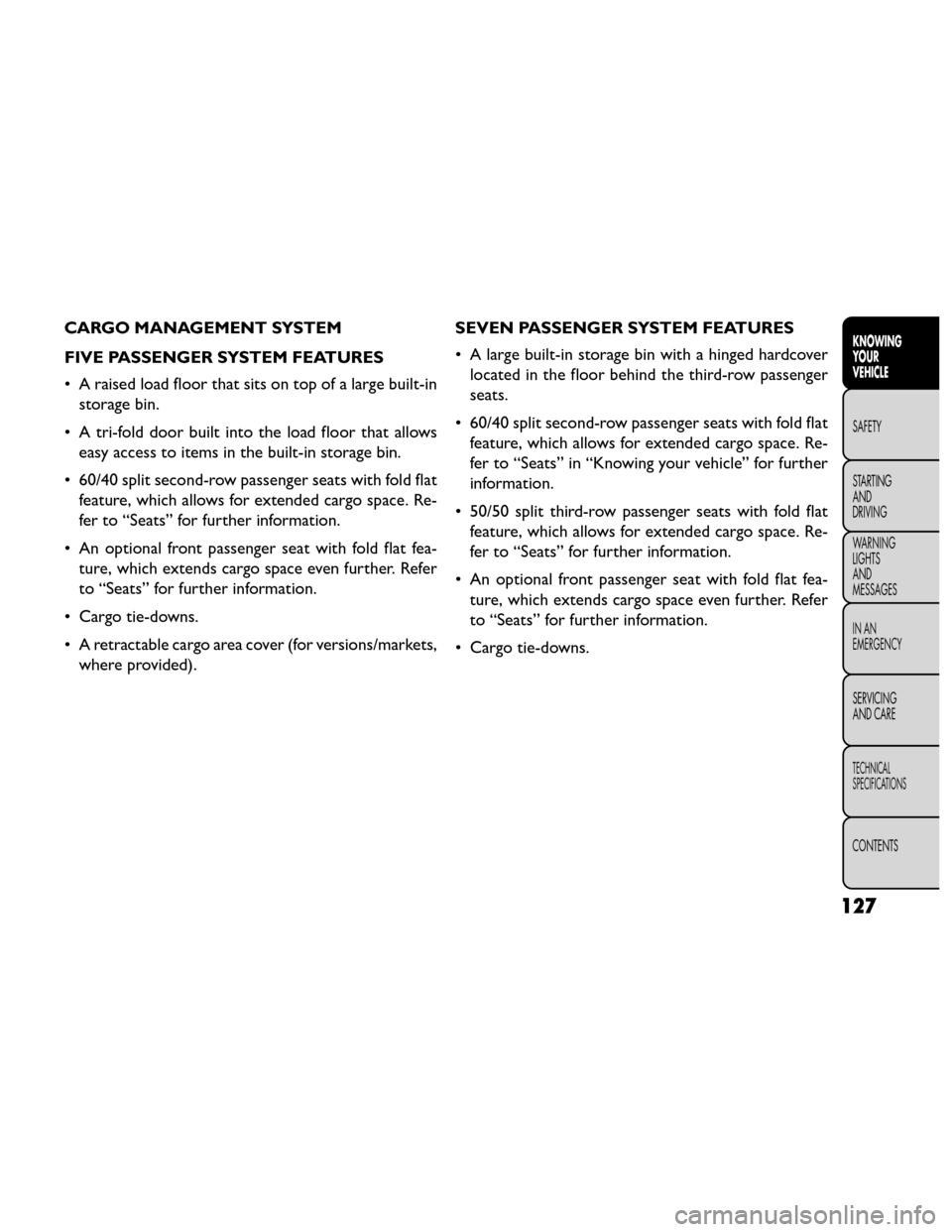
CARGO MANAGEMENT SYSTEM
FIVE PASSENGER SYSTEM FEATURES
• A raised load floor that sits on top of a large built-instorage bin.
• A tri-fold door built into the load floor that allows easy access to items in the built-in storage bin.
• 60/40 split second-row passenger seats with fold flat feature, which allows for extended cargo space. Re-
fer to “Seats” for further information.
• An optional front passenger seat with fold flat fea- ture, which extends cargo space even further. Refer
to “Seats” for further information.
• Cargo tie-downs.
• A retractable cargo area cover (for versions/markets, where provided). SEVEN PASSENGER SYSTEM FEATURES
• A large built-in storage bin with a hinged hardcover
located in the floor behind the third-row passenger
seats.
• 60/40 split second-row passenger seats with fold flat feature, which allows for extended cargo space. Re-
fer to “Seats” in “Knowing your vehicle” for further
information.
• 50/50 split third-row passenger seats with fold flat feature, which allows for extended cargo space. Re-
fer to “Seats” for further information.
• An optional front passenger seat with fold flat fea- ture, which extends cargo space even further. Refer
to “Seats” for further information.
• Cargo tie-downs.
127
KNOWING
YOUR
VEHICLE
SAFETY
STARTING
AND
DRIVING
W
ARNING
LIGHTS
AND
MESSAGES
IN AN
EMERGENCY
SERVICING
AND CARE
TECHNICAL
SPECIFICATIONS
CONTENTS
Page 134 of 388

CARGO TIE-DOWNS
WARNING!
Cargo tie-downs are not safe anchors for
a child seat tet
her strap. In a sudden stop
or collision, a tie-down could pull loose and allow
the child seat to come loose. A child could be
badly injured. Use only the anchors provided for
child seat tethers.
Cargo tie-downs are located on both rear trim panels.
These tie-downs should be used to secure loads safely
when the vehicle is moving.
(fig. 108)
WARNING!
The weight and position of cargo and
passenger s
can change the vehicle cen-
ter of gravity and vehicle handling.To avoid loss of
control resulting in personal injur y, follow these
guidelines for loading your vehicle:
• Do not carry loads that exceed the load limits de- scribed on the label attached to the left door or left
door center pillar.
• Always place cargo evenly on the cargo floor. Put heavier objects as low and as far forward as possible.
• Place as much cargo as possible in front of the rear axle. Too much weight or improperly placed weight
over or behind the rear axle can cause the vehicle to
sway.
• Do not pile luggage or cargo higher than the top of the seatback. This could impair visibility or become a
dangerous projectile in a sudden stop or collision.
• To help protect against personal injury, passengers should not be seated in the rear cargo area. The rear
cargo space is intended for load carrying purposes
only, not for passengers, who should sit in seats and
use seat belts.
(fig. 108)
Cargo Tie-Downs
128
KNOWINGYOUR
VEHICLE
SAFETY
STARTING AND
DRIVING
W
ARNING LIGHTS AND
MESSAGES
IN AN
EMERGENCY
SERVICING AND CARE
TECHNICAL
SPECIFICATIONS
CONTENTS
Page 135 of 388
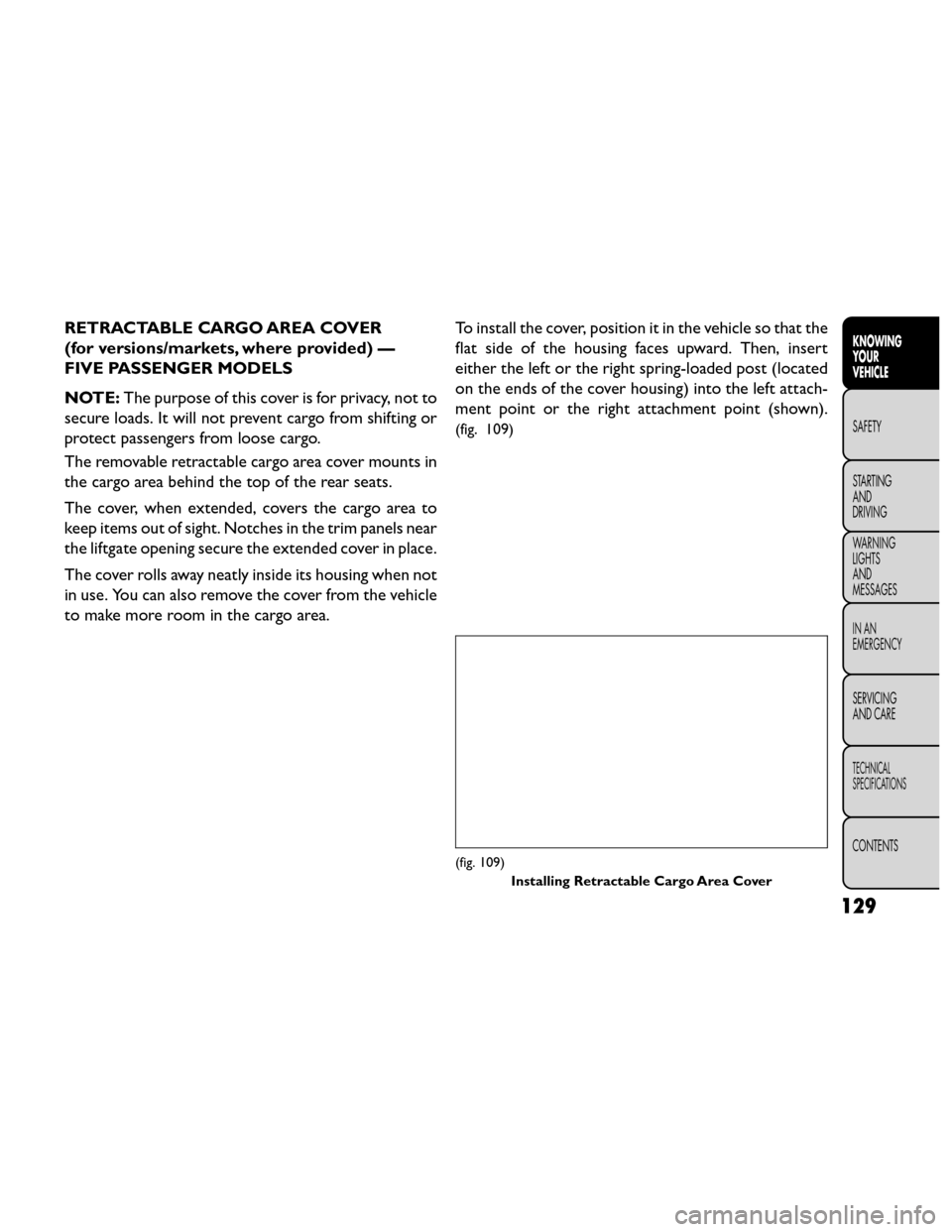
RETRACTABLE CARGO AREA COVER
(for versions/markets, where provided) —
FIVE PASSENGER MODELS
NOTE:The purpose of this cover is for privacy, not to
secure loads. It will not prevent cargo from shifting or
protect passengers from loose cargo.
The removable retractable cargo area cover mounts in
the cargo area behind the top of the rear seats.
The cover, when extended, covers the cargo area to
keep items out of sight. Notches in the trim panels near
the liftgate opening secure the extended cover in place.
The cover rolls away neatly inside its housing when not
in use. You can also remove the cover from the vehicle
to make more room in the cargo area. To install the cover, position it in the vehicle so that the
flat side of the housing faces upward. Then, insert
either the left or the right spring-loaded post (located
on the ends of the cover housing) into the left attach-
ment point or the right attachment point (shown).
(fig. 109)
(fig. 109)
Installing Retractable Cargo Area Cover
129
KNOWING
YOUR
VEHICLE
SAFETY
STARTING
AND
DRIVING
W
ARNING
LIGHTS
AND
MESSAGES
IN AN
EMERGENCY
SERVICING
AND CARE
TECHNICAL
SPECIFICATIONS
CONTENTS
Page 136 of 388
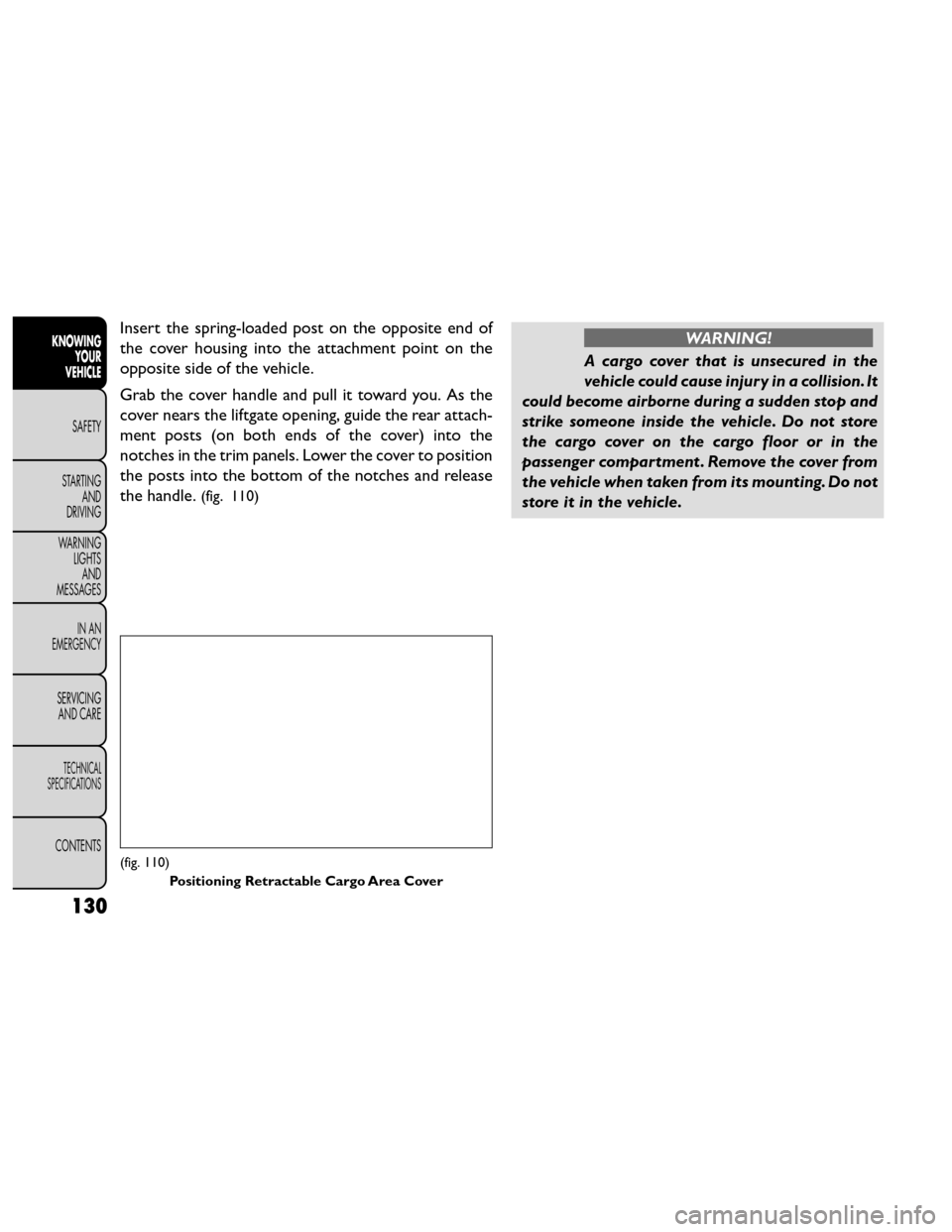
Insert the spring-loaded post on the opposite end of
the cover housing into the attachment point on the
opposite side of the vehicle.
Grab the cover handle and pull it toward you. As the
cover nears the liftgate opening, guide the rear attach-
ment posts (on both ends of the cover) into the
notches in the trim panels. Lower the cover to position
the posts into the bottom of the notches and release
the handle.
(fig. 110)
WARNING!
A cargo cover that is unsecured in the
vehicle c
ould cause injury in a collision. It
could become airborne during a sudden stop and
strike someone inside the vehicle. Do not store
thecargocoveronthecargofloororinthe
passenger compartment . Remove the cover from
the vehicle when taken from its mounting. Do not
storeitinthevehicle.
(fig. 110)
Positioning Retractable Cargo Area Cover
130
KNOWINGYOUR
VEHICLE
SAFETY
STARTING AND
DRIVING
W
ARNING LIGHTS AND
MESSAGES
IN AN
EMERGENCY
SERVICING AND CARE
TECHNICAL
SPECIFICATIONS
CONTENTS
Page 137 of 388
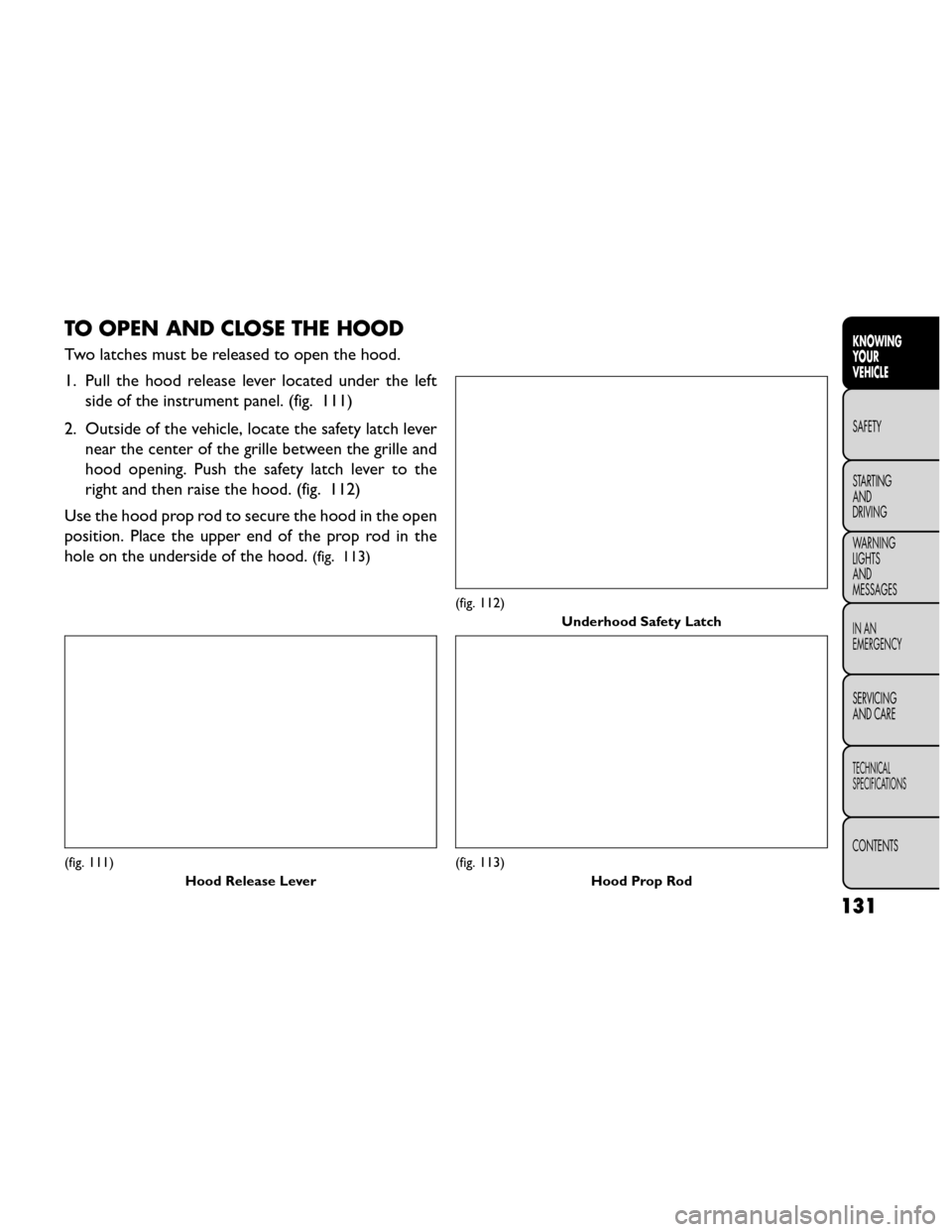
TO OPEN AND CLOSE THE HOOD
Two latches must be released to open the hood.
1. Pull the hood release lever located under the leftside of the instrument panel. (fig. 111)
2. Outside of the vehicle, locate the safety latch lever near the center of the grille between the grille and
hood opening. Push the safety latch lever to the
right and then raise the hood. (fig. 112)
Use the hood prop rod to secure the hood in the open
position. Place the upper end of the prop rod in the
hole on the underside of the hood.
(fig. 113)
(fig. 111) Hood Release Lever
(fig. 112)Underhood Safety Latch
(fig. 113) Hood Prop Rod
131
KNOWING
YOUR
VEHICLE
SAFETY
STARTING
AND
DRIVING
W
ARNING
LIGHTS
AND
MESSAGES
IN AN
EMERGENCY
SERVICING
AND CARE
TECHNICAL
SPECIFICATIONS
CONTENTS
Page 138 of 388

To prevent possible damage:
•Before closing hood, make sure the
hood prop rod is fully seated into its
storage retaining clips.
• Do not slam the hood to close it . Use a firm
downward push at the center front edge of the
hood to ensure that both latches engage. Never
drive your vehicle unless the hood is fully closed,
with both latches engaged.
WARNING!
Be sure the hood is fully latched before
driving y
our vehicle. If the hood is not
fully latched, it could open when the vehicle is in
motion and block your vision. Failure to follow
this warning could result in serious injury or
death.
ROOF LUGGAGE RACK
(for versions/markets, where
provided)
The roof rack side rails on your vehicle are NOT
designed to carry a load without the addition of cross-
bars. Metal Crossbars can be purchased from your
FIAT dealer to provide a functional roof rack system.
External racks do not increase the total load carrying
capacity of the vehicle. Be sure that the total occupant
and luggage load inside the vehicle plus the load on the
luggage rack do not exceed the maximum vehicle load
capacity.
The roof rack cross rails and side rails together are
designed to carry cargo weight. The load must not
exceed 150 pounds or 68 kg, and it should be distrib-
uted uniformly over the cross rails.
WARNING!
Cargo must be securely tied before driv-
ing y our
vehicle. Improperly secured
loads can fly off the vehicle, particularly at high
speeds, resulting in personal injury or property
damage. Follow the roof rack cautions when
carrying cargo on your roof rack.
132
KNOWING YOUR
VEHICLE
SAFETY
STARTING AND
DRIVING
W
ARNING LIGHTS AND
MESSAGES
IN AN
EMERGENCY
SERVICING AND CARE
TECHNICAL
SPECIFICATIONS
CONTENTS
Page 139 of 388

•To prevent damage to the roof of your
vehicle, DO NOT carry any loads on the
roof rack without the crossbars installed.
The load should be secured and placed on top of
the crossbars, not directly on the roof. If it is
necessary to place the load on the roof, place a
blanket or other protective layer between the
load and the roof surface.
• To avoid damage to the roof rack and vehicle,
do not exceed the maximum roof rack load ca-
pacity of 68 kg. Always distribute heavy loads as
evenly as possible and secure the load appropri-
ately.
• Long loads, which extend over the windshield,
such as wood panels or surfboards, should be
secured to both the front and rear of the vehicle.
• Travel at reduced speeds and turn corners care-
fully when carrying large or heavy loads on the
roof rack. Wind forces, due to natural causes or
nearby truck traffic , can add sudden upward
loads.This is especially true on large flat loads and
may result in damage to the cargo or your vehicle.BRAKE SYSTEM
Your vehicle is equipped with dual hydraulic
brake systems. If either of the two hydraulic
systems loses normal capability, the remaining system
will still function. However, there will be some loss of
overall braking effectiveness. This will be evident by
increased pedal travel during application and greater
pedal force required to slow or stop the vehicle. In
addition, if the malfunction is caused by a leak in the
hydraulic system, the “Brake System Warning Light”
will turn on as the brake fluid level drops in the master
cylinder.
In the event power assist is lost for any reason (i.e.,
repeated brake applications with the engine OFF) the
brakes will still function. However, the effort required
to brake the vehicle will be much greater than that
required with the power system operating.
133
KNOWING
YOUR
VEHICLE
SAFETY
STARTING
AND
DRIVING
W
ARNING
LIGHTS
AND
MESSAGES
IN AN
EMERGENCY
SERVICING
AND CARE
TECHNICAL
SPECIFICATIONS
CONTENTS
Page 140 of 388

WARNING!
• Riding the brakes can lead to brake
failure an
d possibly a collision. Driving
with your foot resting or riding on the brake
pedal can result in abnormally high brake tem-
peratures, excessive lining wear, and possible
brake damage.You would not have your full brak-
ing capacity in an emergency.
• Driving a vehicle with the “Brake Warning
Light” on is dangerous. A significant decrease in
braking performance or vehicle stability during
brakingmayoccur.Itwilltakeyoulongertostop
the vehicle or will make your vehicle harder to
control. You could have a collision. Have the ve-
hicle checked immediately. ANTI-LOCK BRAKE SYSTEM (ABS)
This system aids the driver in maintaining vehicle con-
trol under adverse braking conditions. The system
controls hydraulic brake pressure to prevent wheel
lock-up to help avoid skidding on slippery surfaces
during braking. Refer to “Anti-Lock Brake System
(ABS)” under “Knowing Your Vehicle/Electronic Brake
Control System” for further information.
WARNING!
The ABS cannot prevent the natural laws
of physi cs
from acting on the vehicle, nor
can it increase the traction afforded by prevailing
road conditions. ABS cannot prevent accidents,
including those resulting from excessive speed in
turns, driving on very slippery surfaces, or hydro-
planing. The capabilities of an ABS-equipped
vehicle must never be exploited in a reckless or
dangerous manner, which could jeopardize the
user's safety or the safety of others.
134
KNOWING YOUR
VEHICLE
SAFETY
STARTING AND
DRIVING
W
ARNING LIGHTS AND
MESSAGES
IN AN
EMERGENCY
SERVICING AND CARE
TECHNICAL
SPECIFICATIONS
CONTENTS